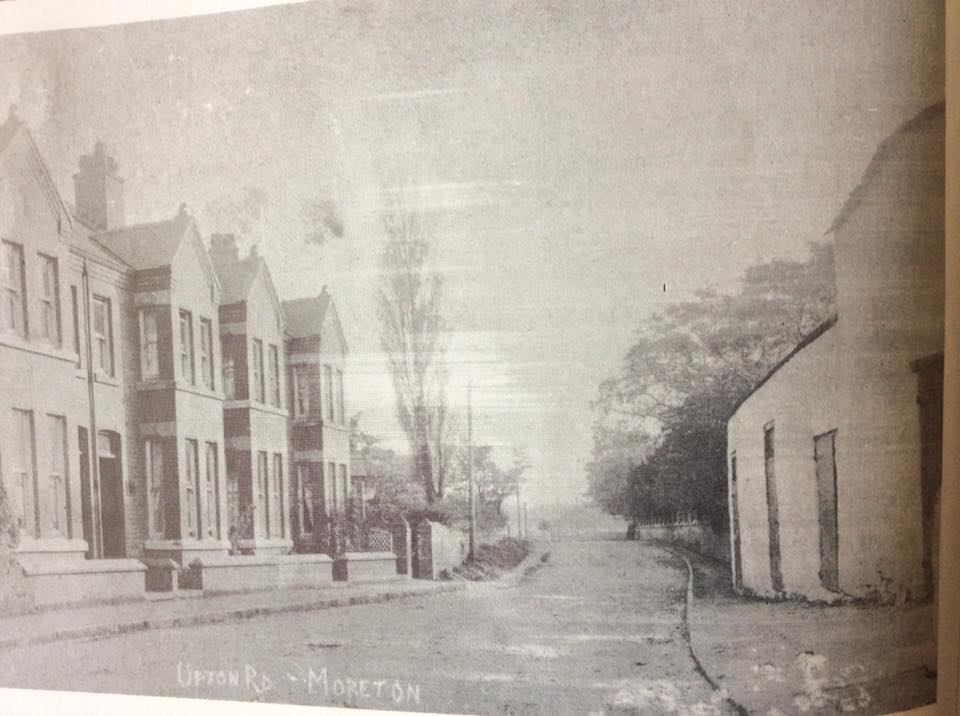| The book, The Hundred of Wirral, by Phillip
Sulley, published in 1889, describes
Moreton as this: |

This was 1900 - the nearest to 1889 as I could find |
| The township of Moreton
cum Lingham, situated 5 miles from Birkenhead, contains 1202 acres, the
valuation being £3,103 10s and the population being 424. In 1801 the
population was 210, and in 1845, 330, the valuation being £927. There
are 88 dwelling houses, three licensed, The Plough Inn & Druids Arms;
The Farmers Arms and The Coach & Horses. There is also a police station,
and the Hoylake & Deeside Railway Company have a station in the
township, but, unfortunately, some distance from the village. |
| The manor of Moreton, together with the other
townships, which formed the ancient ecclesiastical parish of Bidston,
formed a part of the Barony of Dunham Massey. It is not mentioned in
Domesday. It passed through the possession of the Earls of Derby into
that of the Vyney Family and is now the property of Robert C D'Arcy
Vyner, esquire. The freeholders attended the manorial court at Bidston,
but the last court was held in 1886, at Moreton. Messrs Webster, of
Overchurch, also own land and freeholders have lately become very
numerous. There are four farms of 100 acres and upwards. |
| In 1863 the townships of Moreton and Saughall
Massey were formed into an ecclesiastical parish under Bidston, a
church, vicarage and schools having been erected by the munificence of
the late William Inman, of Upton Manor, at a cost of about £8000. The
church, Christ Church, is a beautiful structure of the early english
order of architecture, consisting of a nave and chancel with two small
transepts, forming the vestry and organ chamber. An elegant spire,
about 100 feet in height, stands at the north west end of the nave and
the base forms a baptistry. There is a small organ. The chancel window
of four light is filled in with representations of the nativity,
baptism, last supper and crucifixion. The west window of three lights
represents Christ and his Disciples. There is a memorial tablet to the
founder of the church, who is burind in the churchyard, bearing the
inscription: |
| To William Inman esq |
| of Upton Manor |
| The builder of this church |
| the friend and perpetual benefactor of this
parish |
| The originator of steamship emigration |
| of |
| stainless honour |
| unfailing friendship |
| generous heart |
| and |
| open hand |
| This tablet is erected by grateful and attached
friends |
| AD 1881 |
| There is also a fine brass to Rosa (d 1879),
wife of Thomas Webster, esq, and daughter of William Cliff, esq, of
Liverpool - to whose memory her father erected also the Home for Aged
Mariners at Egremont. There are 30 seats, of which 153 are free, 71
appropriated, and 96 subject to rent. In the churchyard are the
burial places of the late William Inman, of Upton Manor, and of the
Websters, of Upton and Overchurch. |
| The incumbent of the parish is the Rev Matthew
Fearnley M.A. to whom the tithes are paid, the representatives of the
late William Inman being the patrons. The value of the living is returned
to the clergy list as £208, and the population of the parish, 615. The
average attendance at the schools is about 100. |
| The was anciently a small chapel of ease at the
foot of Chapel Hill*, which was pulled down, according to Bishop
Gastrell, about the year 1690. No trace of it remains, the buildings
being nearly all modern. The township has been greatly improved of late,
especially by the erection of the church and schools, and it no longer
merits the description of it by Mortimer in 1845, which is intersting
for comparison "it is situated in a dreary flat, close to the shores of
the sea, with roads exceedingly bad, and a bridge as dangerous to
travellers as it is disgraceful to the county. It is, in every point of
view, an extremely poor village" |
| The changes of the last half century have been truly great and
happy. |
| *Chapel Hill was in the region of Digg Lane. |
 |